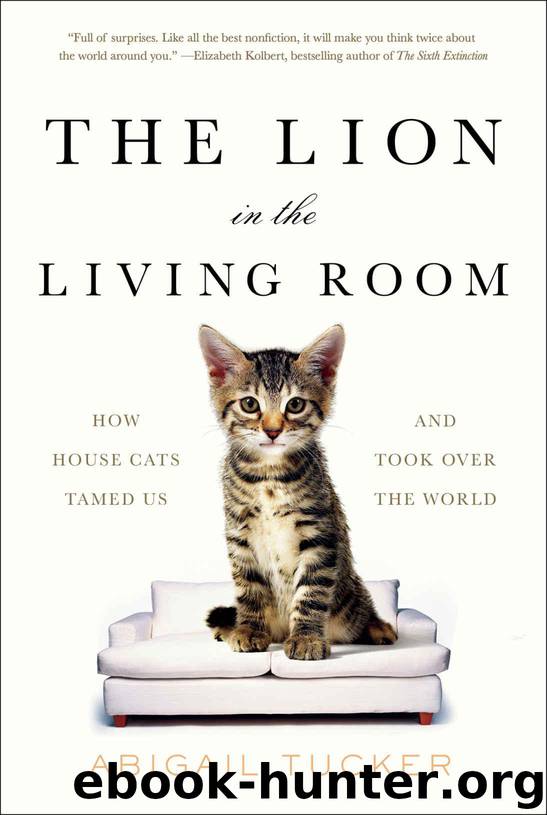The Lion in the Living Room: How House Cats Tamed Us and Took Over the World by Tucker Abigail

Author:Tucker, Abigail [Tucker, Abigail]
Language: eng
Format: azw3
Publisher: Simon & Schuster
Published: 2016-10-18T04:00:00+00:00
The father of human–house cat research is an American biologist named Dennis Turner. He began his scientific career in the 1970s with a very different animal subject: the vampire bat, studying the bat’s “blood source selection” and other habits in the jungles of Costa Rica. Several times Turner was selected as a blood source himself, and after a bite from a rabid vampire, was subjected to the infamous series of 21 vaccination shots to save his life.
Perhaps this dicey fieldwork informed Turner’s decision to study a cuddlier creature. Once back in the safety of his own living room, he contemplated switching to a variety of animals and at one point even entertained an offer to lead the famous Serengeti Lion Project.
“Exactly in the moment when I was considering taking over the Lion Project,” Turner recalls, “my house cat came out from under the table and meowed. I jokingly said to her, ‘You’ll be my lion.’ And then it clicked.”
A few scientists were already investigating cats’ outdoor roaming and hunting habits. But Turner was more interested in our increasingly intimate, and indoor, interspecies relationship. There was much to ponder: Do thermoregulatory problems explain why certain cats flee our laps? Does owner gender shape the play dynamic? He published papers with intriguing if oblique titles like “Spouses and Cats and Their Effects on Human Mood.”
Several other labs around the world followed in Turner’s footsteps, and soon lucky graduate students were rigorously petting kittens for their research projects. Their collective efforts now make up a small yet lively body of literature: as part of one recent study, researchers placed “a plush owlet with large glass eyes” on the floor of a home and watched the resident cats’ reactions, recording behaviors such as lick lips and tail undulations and “events,” including cats running at a “gallop” and “cat’s eyes stretched open more widely than normal (‘bug-eyed’).”
Happily, the cat scientists’ exertions converged with the brand-new, but expanding, human-animal interaction research field. As agriculture and animal husbandry fade from daily life, it’s only natural to try and fathom our deepening relationships with those new beasts of emotional burden, household pets. And being self-interested creatures, humans have become especially interested in the quantifiable impacts that pets have on our health.
The groundbreaking study in this area was published in 1980, when a researcher named Erika Friedmann tracked factors influencing heart attack survival, and found that 94 percent of pet-owning patients survived the following year, while just 72 percent of nonpet owners lived. The resulting mantra that “pets are good for us” has since become entrenched. In his book The Healing Power of Pets, celebrity veterinarian and frequent Today show guest Marty Becker sums up the view this way: “A pet can be a miracle drug that keeps you healthier; home instead of hospitalized; reduc[ing] your risk of heart attacks . . . with the lick of a tongue, wag of a tail or rhythmic purring . . . and not for a fortune, but at the price of a can of Fancy Feast or Friskies.
Download
This site does not store any files on its server. We only index and link to content provided by other sites. Please contact the content providers to delete copyright contents if any and email us, we'll remove relevant links or contents immediately.
The Lonely City by Olivia Laing(4723)
Animal Frequency by Melissa Alvarez(4380)
All Creatures Great and Small by James Herriot(4206)
Walking by Henry David Thoreau(3867)
Exit West by Mohsin Hamid(3759)
Origin Story: A Big History of Everything by David Christian(3609)
COSMOS by Carl Sagan(3528)
How to Read Water: Clues and Patterns from Puddles to the Sea (Natural Navigation) by Tristan Gooley(3380)
Hedgerow by John Wright(3252)
The Inner Life of Animals by Peter Wohlleben(3222)
How to Read Nature by Tristan Gooley(3221)
How to Do Nothing by Jenny Odell(3209)
Project Animal Farm: An Accidental Journey into the Secret World of Farming and the Truth About Our Food by Sonia Faruqi(3154)
Origin Story by David Christian(3125)
Water by Ian Miller(3103)
A Forest Journey by John Perlin(3016)
The Plant Messiah by Carlos Magdalena(2852)
A Wilder Time by William E. Glassley(2799)
Forests: A Very Short Introduction by Jaboury Ghazoul(2772)
